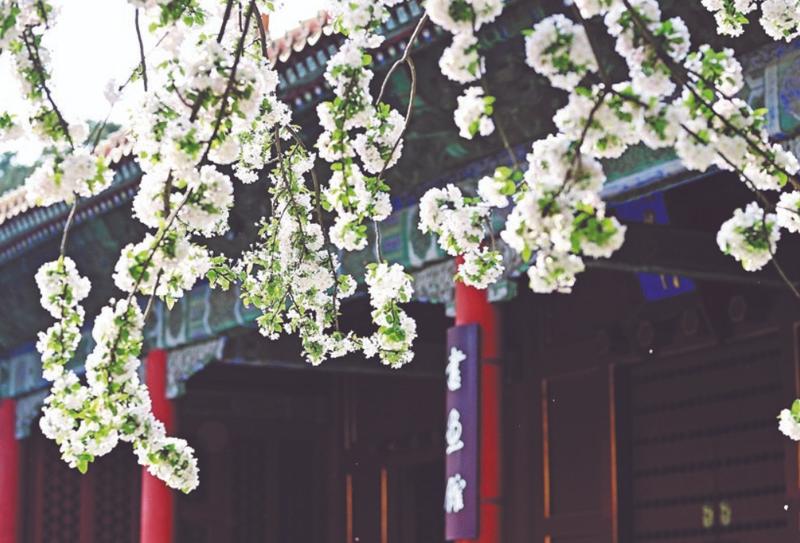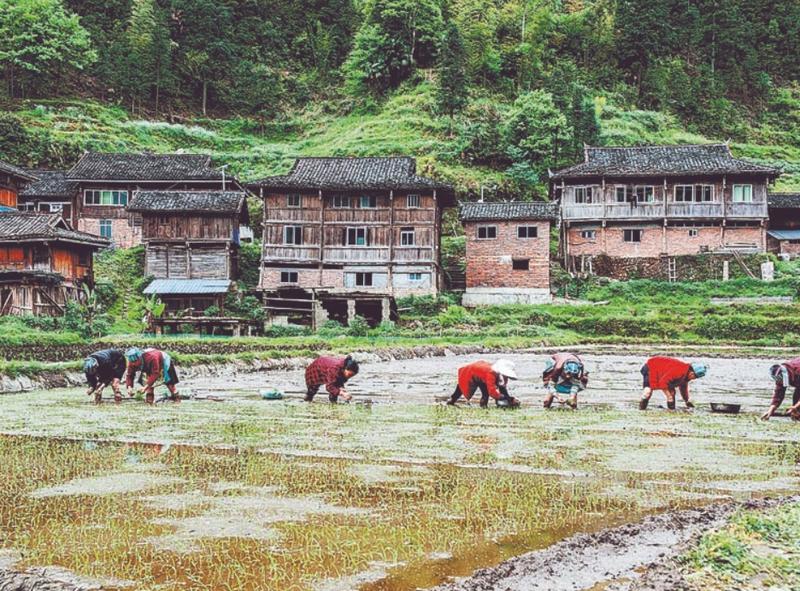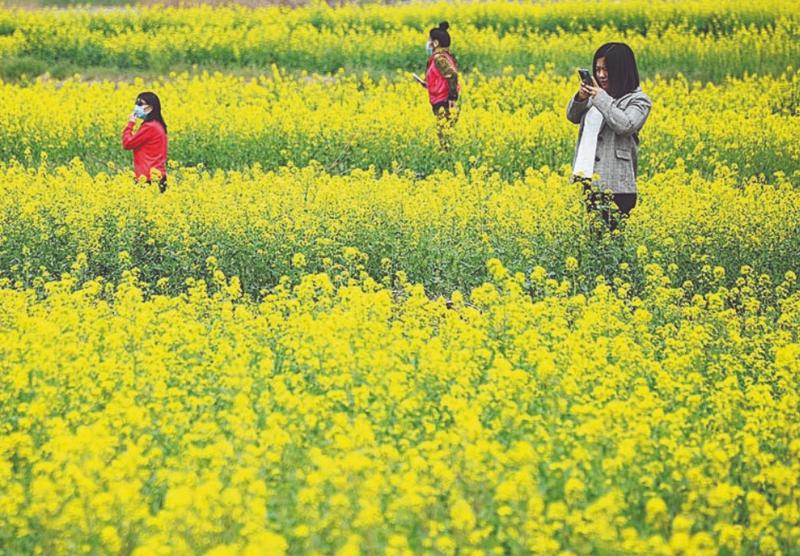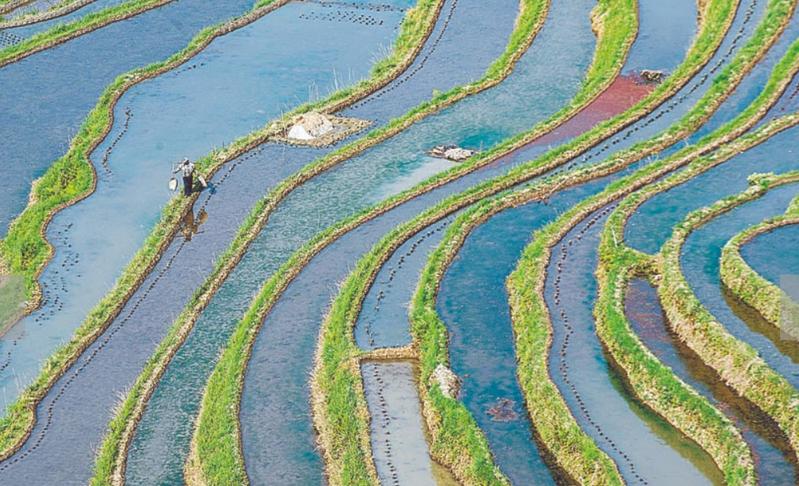As China prepares to mark the advent of summer, legend has it that the sixth of the Twenty-four Solar Terms has a very literal meaning, and direct links to the nation's written language, Cheng Yuezhu reports.
 The Palace Museum in Beijing is adorned with blossoms. (PHOTO / XINHUA)
The Palace Museum in Beijing is adorned with blossoms. (PHOTO / XINHUA)
Ancient people seem to have fanciful imaginations of the rain. When it sometimes "rains cats and dogs" or "rains pennies from heaven" in the English-speaking world, in China we will soon welcome the annual period of Grain Rain.
Just as no one would take the English expressions literally, Grain Rain is the sixth of the Twenty-four Solar Terms in the traditional Chinese calendar, which this year starts from April 20.
Its name is a reference to the Chinese saying "rain produces hundreds of grains", denoting an association between weather and farming. As the last solar term in spring, this period sees the temperature rise and rainfall increase, creating an ideal environment for the growth of flora and fauna.
On the first day, duckweed starts to grow; after five days, cuckoos flutter their wings; another five days later, hoopoes can be spotted on mulberry trees-ancient Chinese painted this pastoral picture from their naturalistic observations during the solar term.
These images, however, are not random sightings collaged to depict the vibrant scenes of late spring, but closely related to the natural changes, and bear instructional value to China's thousands of years of agricultural and sericultural history.
Duckweed thrives in a warm temperature, meaning an end to cold spells; cuckoos' distinctive singing, mimicking the Chinese phrase "spread the grains", is often believed to be urging farmers to start sowing; and hoopoes often build their nests on mulberry trees during these periods, a prime time to raise silkworms.
For millennia, stemming from China's agrarian society to today, farmers view the solar term as an important guideline for their agricultural activities.
"Grain Rain is still relevant to modern agriculture. It links grain with rain, reflecting an increasing amount of precipitation, which is good for the growth of crops. For farmers, it is a good time to sow," says Yan Jianbin, a specialist in festival culture from Shaanxi's Northwest University.
It might not be so well-known that in Chinese mythology an actual "grain rain" was recorded in the story of Cang Jie, the legendary four-eyed imperial historiographer who invented the first Chinese characters.
Prior to 2500 BC, in order to keep records more efficiently and accurately, Cang Jie originated a set of characters from observing the tracks of birds and mammals. After his groundbreaking invention, grains started to pour down from the sky.
ALSO READ: Remaking devices of yesterday
Though it remains to be evidenced whether the story of Cang Jie bears any grain of truth, the Grain Rain day became a day to honor Cang Jie and the invention of the Chinese language. For thousands of years, in certain regions of China, such as Shaanxi and Henan provinces, locals will visit Cang Jie's temples to offer sacrifices and burn incense, and ceremonies of varying scale are held to pay tribute to him.
 Farmers are busy tending their paddy fields in Congjiang, Guizhou province. (PHOTO / XINHUA)
Farmers are busy tending their paddy fields in Congjiang, Guizhou province. (PHOTO / XINHUA)
According to Yan, Luonan and Baishui counties in Shaanxi province were important locations associated with Cang Jie, and both places would host grand commemorative ceremonies with similar yet characteristic rituals around the Grain Rain day each year.
"According to historical records, the Luonan county magistrate Wang Senwen, during the reign of Emperor Daoguang (1821-50) of the Qing Dynasty (1644-1911), put up a memorial tablet marking the location where Cang Jie created the first 28 pictographic characters. This tablet is now preserved inside the Luonan county museum. In 1877, the county's government built a shrine in honor of Cang Jie and first started hosting official ceremonies in commemoration of him," Yan says.
"Today, the public ceremony has been further upgraded. It is now a grand and solemn event that promotes Chinese language and culture. Apart from this, Luonan county has also started a Cang Jie cultural and tourism festival that encourages the local tourism development."
In Baishui county, which according to a popular legend, is Cang Jie's birthplace, a set of nine rituals has been established as the highest level of tribute to the mythological figure, including the ringing of bells, presenting offerings of food and alcohol, as well as traditional music and poetry performances.
Because of the legend, April 20 has been designated as the annual UN Chinese Language Day since 2010 by the United Nations' Department of Public Information. It is roughly around the Grain Rain day, which falls between April 19-21.
ALSO READ: Driverless vehicles park themselves in rapidly expanding market
At this year's two sessions, Wang Yongchao, deputy to the National People's Congress and director of Guanzhong Folk Art Museum in Xi'an, Shaanxi province, put forward a motion to set up a Chinese language festival on the Grain Rain day each year.
 Colorful blossoming rapeseed flowers draw visitors to Beijing's Pinggu district. (PHOTO / XINHUA)
Colorful blossoming rapeseed flowers draw visitors to Beijing's Pinggu district. (PHOTO / XINHUA)
Wang says that he has witnessed an increasing amount of varied folk events to honor the contribution of Cang Jie every year in the build-up to Grain Rain, and the Chinese language becoming more influential in the international arena.
"Chinese characters are a treasure of the thousands of years of Chinese culture, the spiritual homeland of Chinese people, and an important symbol of cultural identity," Wang says.
Seeing as Grain Rain day is both a day to pay tribute to Cang Jie and the UN Chinese Language Day, he believes setting up a Chinese language festival can enhance a sense of cultural identity and bring people from China's ethnic groups more closely together.
"A Chinese language festival should be connected with the UN Chinese Language Day, to provide the world with an opportunity to learn about Chinese culture, with rich cultural displays and diverse artistic performances," Wang says.
Perhaps because of the positive implications of Grain Rain for agriculture, a major line of work in ancient China, it is a day to honor those who made significant contributions to human civilization, another one of them being Yu the Great, the first emperor of the Xia Dynasty (c.21st century-16th century BC).
 Farmers are busy tending their paddy fields in Congjiang, Guizhou province. (PHOTO / XINHUA)
Farmers are busy tending their paddy fields in Congjiang, Guizhou province. (PHOTO / XINHUA)
Before Yu ascended the throne, an unprecedented flood ravaged the country, which he was tasked with mitigating. The story was passed down that, with the greater good in mind, over the next 13 years he regulated water courses around the country, and he passed by his own home three times, but never once stepped inside.
As Yu is considered a prominent historical figure, emperors from different dynasties visited-either in person or via messenger-today's Shaoxing, Zhejiang province, where Yu was recorded to have been buried, to pay tribute to him.
Since 1995, Zhejiang provincial government and the municipal authorities in Shaoxing again started hosting official ceremonies paying homage to Yu the Great. The custom has been listed as a national intangible cultural heritage since 2006.
Another folk custom on the Grain Rain day, also on the list, is one where fishermen in coastal villages of Rizhao, Shandong province, follow a set of rituals to offer sacrifices to the sea, praying for safety and a bountiful harvest.
For contemporary people, who may not engage in agricultural activities, the solar term is not as familiar as its predecessor Pure Brightness (Qingming), which has gained its prominence in Chinese culture as a day to remember one's ancestors, but Grain Rain still influences people's daily activities.
"The weather changes greatly during the Grain Rain period, which is closely related to healthcare. The southern areas feature frequent rainfall, and the temperature in the northern areas fluctuates. It's a time to protect our bodies from the perils of 'pathogenic dampness' in traditional Chinese medicine", Yan says.
ALSO READ: A new role in business
In order to do so, Yan says that it is a particularly important time to pay extra care to one's liver, by avoiding eating raw or cold food or staying up late at night.
Going with the grain, other customary activities of the period include appreciating the peony, eating Chinese toon leaves, and taking tea, while savoring the last precious days of spring.


